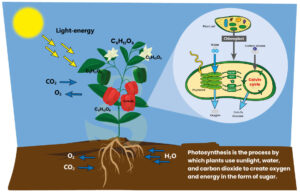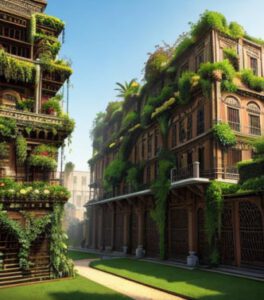
Brix in relation to crop health and quality
Brix in relatie tot gezondheid en kwaliteit van gewassen. De zoete wetenschap van Brix. Brix in relatie tot gezondheid en kwaliteit van gewassen. Brix-waarde verwijst
As urbanisation increases, cities around the world are struggling with rising temperatures, a phenomenon exacerbated by the emergence of heat islands. Urban Heat Islands (UHIs) occur when the concentration of heat-absorbing surfaces, such as asphalt and concrete, leads to higher temperatures in urban areas compared to their rural surroundings. However, an effective and aesthetically pleasing solution lies in incorporating more green spaces in cities, by strategically planting trees, vegetation and creating natural shade.
The introduction of green spaces in urban environments has proven to be an important strategy to mitigate the adverse effects of UHIs. Trees, with their wide canopies and ability to provide shade, play a vital role in cooling urban areas. Studies have shown that strategically planting trees can reduce ambient temperatures by a few degrees. A few degrees may sound like not much but the impact is more significant than it first appears.

Research in several cities has shown that urban greenery has a significant effect on lowering temperatures. In an urban landscape dominated by concrete and asphalt, temperatures can rise considerably in the summer months. However, areas with lots of trees and greenery have a noticeable cooling effect. A study in Tokyo, for instance, found that neighbourhoods with dense tree canopies had temperatures up to 2-3 degrees Celsius lower than their less green counterparts. Similarly, in cities like Los Angeles and Singapore, initiatives to increase urban greenery led to measurable reductions in ambient temperatures. Which resulted in a noticeably more pleasant living environment for the residents of these cities.
There are more benefits that can be gained by applying more urban green space. These include improved air quality, increased biodiversity, mental and physical well-being and the energy savings it brings.
Improved air quality
Urban greenery not only cools the air but also contributes to improved air quality. Trees act as natural air purifiers by absorbing pollutants and releasing oxygen. The increased presence of greenery can help reduce the negative effects of air pollution and promote a healthier environment for city dwellers.
Enhanced biodiversity
The introduction of green spaces in urban landscapes promotes biodiversity and provides habitats for different flora and fauna. This ecological diversity contributes to a more balanced and resilient urban ecosystem.
Mental and physical well-being
Green spaces are associated with better mental well-being and less stress. Access to nature in urban areas provides residents with opportunities for recreation, relaxation and physical activity. Parks and green corridors can serve as havens for people seeking a respite from the hustle and bustle of city life.
Saving energy
Strategically placed urban greenery can help save energy. The shading effect of trees reduces the average temperature in cities. This reduces the demand for air conditioning, resulting in lower energy consumption and greenhouse gas emissions. Again, you can see that there are multiple benefits to applying more greenery in cities.
There are various methods by which urban greening can be realised. What is possible and desirable will have to be considered per situation. A combination of possibilities usually gives the best solution to the increasing nuisance of Urban Heat Islands.
Establishing urban forests consists of planting a diverse range of trees in designated areas. These mini-forests can contribute significantly to temperature reduction and offer a variety of environmental benefits. Initiatives such as "Million Trees" campaigns have been successful in several cities worldwide. You can also think about green roofs and walls. Integrating vegetation on building surfaces is a also an effective strategy. Green roofs and walls not only provide insulation, but also contribute to the overall aesthetics of the urban landscape. They help combat the heat island effect by reducing the absorption and retention of heat by buildings. Encouraging community involvement in cultivating green spaces in community gardens also enhances the sense of ownership and pride. Community gardens not only provide fresh produce but also these contribute to a cooler and more sustainable urban environment.
Transforming urban landscapes into cooler, greener spaces is a versatile solution to the challenges posed by Urban Heat Islands. By strategically integrating trees, plants and natural shade, cities can not only combat rising temperatures, but also enjoy a host of additional benefits. From improved air quality to increased well-being and energy savings, the positive impact of urban greenery is undeniable. In the pursuit of more sustainable and liveable cities, integrating green space should become a priority. Embracing the urban green revolution can create environments that not only look beautiful, but also contribute to healthier and happier urban living.


Brix in relatie tot gezondheid en kwaliteit van gewassen. De zoete wetenschap van Brix. Brix in relatie tot gezondheid en kwaliteit van gewassen. Brix-waarde verwijst

Het endocannabinoïde systeem begrijpen Een korte handleiding voor CB1- en CB2-receptoren Het endocannabinoïde systeem (ECS) speelt een fundamentele rol bij het reguleren van verschillende fysiologische

Photosynthesis Photosynthesis is the process by which green plants, algae and some bacteria convert light energy into energy in the form of glucose. This process mainly takes place

7 handy tips to prepare for the new garden season Gardening tasks when the spring jitters strike: Spring is a time of renewal and

The development of hydroponic fertilisers through the ages The history of hydroponics is a story of innovation and perseverance, rooted in the quest of the

Creating a successful indoor grow involves more than just light and water. Here are 7 tips to boost your indoor garden.
Brix in relatie tot gezondheid en kwaliteit van gewassen. De zoete wetenschap van Brix. Brix in relatie tot gezondheid en kwaliteit van gewassen. Brix-waarde verwijst
Het endocannabinoïde systeem begrijpen Een korte handleiding voor CB1- en CB2-receptoren Het endocannabinoïde systeem (ECS) speelt een fundamentele rol bij het reguleren van verschillende fysiologische
Photosynthesis Photosynthesis is the process by which green plants, algae and some bacteria convert light energy into energy in the form of glucose. This process mainly takes place
7 handy tips to prepare for the new garden season Gardening tasks when the spring jitters strike: Spring is a time of renewal and
The development of hydroponic fertilisers through the ages The history of hydroponics is a story of innovation and perseverance, rooted in the quest of the
Creating a successful indoor grow involves more than just light and water. Here are 7 tips to boost your indoor garden.
Home » Transforming urban heat islands into cool and liveable cities

Because growing your own is a craft. It takes time, energy, focus, attention, maybe even love. At your own pace, in your own environment. You are the creator.